Small thumbs are a part of radial longitudinal deficiency– the official name is hypoplastic thumb meaning underdeveloped thumb. Sometimes this is an isolated problem and sometimes it is associated with abnormalities of the forearm and wrist (radial longitudinal deficiency)- http://congenitalhand.wustl.edu/2011/07/radial-longitudinal-deficiency.html
A small thumb can be on one hand or both but most of the time the hands are not exactly the same (meaning one is worse than the other). There are 4 main parts to the small thumb: size, stability, and muscle, and motion.
1) As the name implies, the small thumb is small. It is short and can be thin.
2) It is also unstable at the MCP joint which is the joint (where motion happens) between the thumb and the hand. The problem with instability at this location is that it affects how you use your hand. An unstable thumb usually prevents good, strong pinch.
3) The muscles of the thumb are called the thenar eminence. These muscles are used to position the thumb to allow best function- things like holding a soda can or pinching. If these muscles are small or absent then the thumb-= the most important of the fingers- can’t work correctly. If the thumb is not working correctly, the patient will have less use of the entire hand.
4) Lastly, a small thumb may have limited motion. This can be due to the limited muscles or it can be due to abnormal tendons from the forearm- tendons that can have abnormal connections. The thumb may not bend or straighten well.
The good news about the small thumb is that surgery can be helpful to correct it. Surgery can make it stronger and more stable and more mobile. Surgery can never make the thumb normal but it can make a better thumb. If a thumb is really small, sometimes the thumb may be best treated with pollicization, rather than reconstruction. http://congenitalhand.wustl.edu/2011/10/pollicization-creating-new-thumb.html
If the thumb is reconstructed without pollicization, there are 3 basic steps. 1) Give the thumb more muscle. There are choices for this step but both work well (flexor tendon to ring finger or muscle from pinky side of hand). 2) Make the MCP joint stable 3) Deepen the space between the thumb and index finger, the first web space. This makes the thumb longer and able to grab larger objects.
These pictures are unusual in that they are of an 11 year old with small thumb or hypoplastic thumbs on both sides.
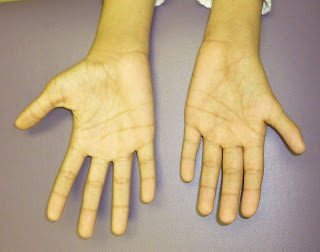 |
| Small thumbs on both sides. The left hand (the one on the right side of the picture) is worse- smaller and with less muscle. |
 |
| This picture is of the child with small thumbs trying to bring the thumbs up. Neither side does it well. |
 |
| Another view of the small thumbs trying to lift the thumbs. |
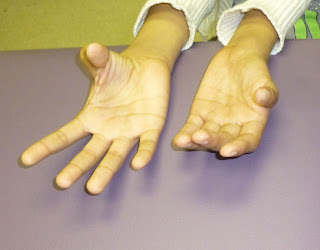 |
| Yet another view of small thumbs, attempting to lift. |
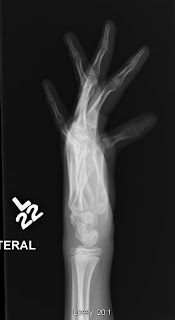 |
| X-ray of small thumb (the left side) showing a small thumb with unstable joint. |
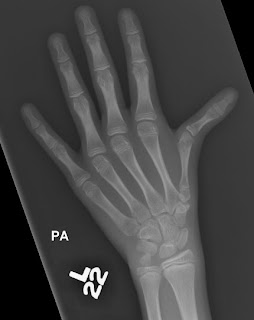 |
| Great x-ray of small thumb, unstable. Notice the bend in the thumb. |
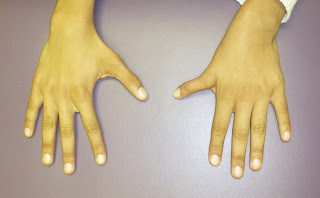 |
| Last picture of small thumbs. Notice the the left thumb (on the right) is smaller or more angulated than the other one. |







My 8 month old grandson was born with a thumb smaller than the other one. He doesn't use it. I wonder if anyone knows of this type of defect and/or if it can be fixed. The pediatrician said to wait until the baby is a year old to have it checked. I say the sooner the better. Anyone else have experience with this type of problem.
There are selected hand surgeons with experience in caring for kids with birth differences like your grandson. One of these doctors will likely be able to make the right diagnosis and offer options for treatment. I strongly believe that you should find a doctor who does a lot of this kind of work (rather than a doctor who only occasionally sees kids like your grandson). I do agree that seeing someone sooner makes sense (although usually treatment does not occur before one year of age).
I have identical twins, one who I have noticed has a small and unusually shaped thumb and hand around the base of the thumb. My twins have Ehlers Danlos and hypermobility. Might there be any connection?
Thank you for the question. Certainly x-rays would be helpful to understand whether this is a bony development issue or potentially a joint issue. There is a risk of base of the thumb dislocation. I hope that helps. An experienced hand surgeon with pediatric experience should be able to provide insight.
Hi.. i was born without a thumb on my right hand and my elbow doesnt straighten all the way.. i also have a small thumb on my left and and it looks pretty weird.. i had carpertunel surgery on my left hand andd my thumb has never been the same.. ever since then it has been pretty painful.. but not all the time just times when i use it a lot.. most doctors in this area wont even thpugh my hand.. i usually have to make a trip to stl and i dont really wanna spend the money for them to tell me rhey cant do anything about it.. i guess my question is do you think there is anything that can be done to help it
Hello JMJ. You likely have radial deficiency which explains a small thumb on one side and an absent thumb on the other side. I am not sure why your small thumb is painful- sometimes there is a treatment but that is impossible to know without an examination. Good luck.
Hello Mr Goldfarb, I wondered if there was a way I could post a photo of my daughters thumb for you to look at and give me your opinion please? Thank you.
Hello. Feel free to email me at the blog address: congenitalhand@wudosis.wustl.edu
Is this the same as when one thumb of the hand is big and the other thumb of the hand is smaller? Can this be fixed?even if the kid is already like 14